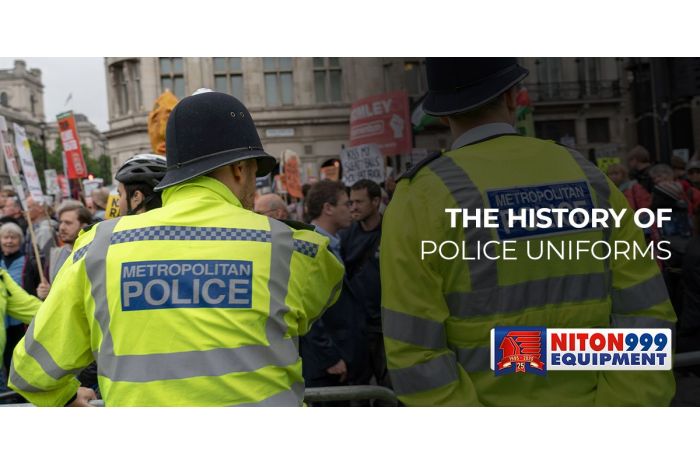Police uniforms have changed over time, but there are still some features that have remained constant for nearly 200 years.
The UK police force and its associated uniforms is largely attributed to Sir Robert Peel, who decided to separate the police’s regalia and uniform from the military.
While uniformed police officers existed before then, it wasn’t until the 19th century that UK police forces began to comply with standardised uniforms and equipment.
This is a guide to the evolution of police uniforms from the past to the present.
History of police uniform
Initial Uniform Designs (1829 - Mid-19th Century)
The standardised UK police uniform is primarily credited to Sir Robert Peel, who established the Metropolitan Police Service in London, England, in 1829.
These early uniforms' design and colour schemes aimed to distinguish the police from the military. At the time, significant public mistrust of the army made this crucial.
The original Metropolitan Police officers were called "Peelers" or "Bobbies". They were typically adorned in blue swallowtail coats with high collars, white trousers in summer, and a cane-reinforced top hat.
This hat could be used as a step to climb or see over walls, demonstrating early considerations for utility in the design. The equipment carried by the officers during these early years was minimal, with a rattle to call for assistance and a wooden truncheon being standard.
Changes in the Late 19th and Early 20th Centuries
In 1863, the Metropolitan Police updated their uniform, replacing the tailcoat with a tunic and the top hat with the custodian helmet.
The helmet was made of cork and covered with fabric. During WW2, all police services wore a plain peaked cap or a military-style steel helmet when appropriate.
Uniforms went through various lengths and styles over the years, with the Metropolitan Police adopting the open-neck style in 1948.
Uniforms in the Mid-20th Century
For much of the twentieth century up until the mid-1990s, male police officers wore a dark blue (almost black) tunic with polished silver buttons (gold for the City of London Police) and trousers of matching colour with a sewn-in truncheon pocket. There was no stab vest, and equipment remained minimal.
Concerns about police officers' safety ultimately caused the uniform to change. Additionally, during the 1990s, it became generally accepted that police officers could patrol in "shirt-sleeve order", removing the need for the jacket.
The Home Office updated the uniform to include black trousers, a shirt, a blue NATO-style V-neck jumper, a stab vest, service belt, and reflective jacket.
Female Officers' Uniforms
The uniforms for female officers have mirrored women's fashion trends of their respective times.
Tunic style, skirt length, and headgear vary by period and force. By the late 1980s, the female working uniform had become identical to the male uniform, except for headgear and sometimes neckwear.
Changes in Headgear
The types of headgear used by police officers have evolved significantly over the years.
The original top hat was replaced by the custodian helmet in 1863 for male officers on foot patrol, and this has become one of the most recognisable symbols of British policing. However, not all forces have retained this style of headwear.
From the late 20th century into the 21st, some forces, such as the West Yorkshire Police and Thames Valley Police, have phased out the custodian helmet, opting for peaked caps and bowler hats instead.
Others have experimented with baseball caps, and the choice of headwear can sometimes vary by role or officer preference.
As of 2021, Essex Police no longer restrict any force-issue headwear by gender. Any new officer recruited may choose between a custodian helmet or bowler hat, plus an additional peaked cap.
What is the Current British Police uniform?
In law enforcement, the appearance of officers has significant implications for public perception, officer safety, and operational efficiency.
Standard Uniform Elements
The uniform of a British police officer today involves a black or very dark navy-blue stab vest worn over a light blue or white shirt with black trousers.
Officers are equipped with sturdy black boots featuring a steel toe for enhanced safety and durability.
Given the unpredictable British weather, officers often sport a waterproof, high-visibility jacket.
What Equipment Does the UK Police Carry?
The equipment carried by UK police officers plays a pivotal role in enabling them to carry out their duties effectively and safely.
This gear ranges from communication devices to less-lethal weapons, all aimed at helping officers manage various situations they may encounter.
Standard Equipment
The standard equipment for UK police officers is carefully selected to ensure they can respond appropriately to a range of incidents. It typically includes:
- Radio: This is an essential piece of equipment for maintaining communication with other officers and command centres.
- Handcuffs: These are used to restrain individuals safely when necessary.
- Baton: A baton can be used in self-defence or to control potentially violent individuals.
- PAVA Spray: This type of pepper spray can temporarily incapacitate an individual, allowing the officer to gain control of a situation without resorting to lethal force.
- First Aid Kit: Officers are often the first on the scene of accidents or violent incidents, and a first aid kit can be crucial in providing immediate medical attention.
- Torch (Flashlight): This helps officers during night patrols or in poorly lit environments.
- Body-Worn Video Camera: These cameras record interactions with the public, providing a valuable record of events that can enhance transparency and accountability.
Special Equipment
In addition to the standard issue, some specially trained officers may carry less-lethal weapons such as Taser devices.
Tasers can immobilise a person from a distance, reducing the need for physical confrontation. They are only used in situations where their use is justified and proportionate.
Furthermore, a few officers, typically those in specialised units or areas with a higher risk of serious violence, are authorised to carry firearms.
Summary: The Evolution of Police Uniforms: A Historical Perspective
Over the centuries, police uniforms have evolved from simple badges and tunics to high-tech protective gear. This shift reflects the changing nature of the threats law enforcement faces and society's evolving expectations and perceptions of policing.
Today, a police officer's uniform is more than just clothing – it serves as a symbol of authority, a tool of protection, and a representation of the values that underpin our community.
However, modern officers’ clothing is considerably more high-tech and emphasises protection.
Niton999 stocks extensive police uniforms and gear. Check out our clothing shop here.
Police Uniforms FAQs
When was the police uniform introduced?
The first standardised police uniform was introduced in London, England 1829. Sir Robert Peel, while establishing the Metropolitan Police Service, saw the need for a uniform that would distinguish officers from the military and symbolise their unique role in society.
When did UK police uniforms change from blue to black?
The transition from blue to black or navy blue for UK police uniforms varied by individual police forces, but most had made the change by the late 20th century. Practical considerations largely drove the shift towards black or navy blue, e.g. black doesn’t show stains easily.






